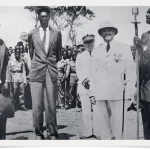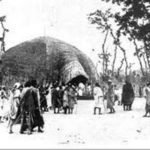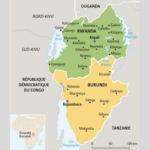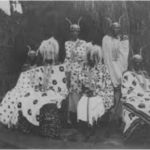Burundi and Rwanda: The Recurring Ntare
In Burundi, south of Rwanda, there occurred a similar process of reconstructing the royal line, a process that assumed the cyclic succession of a given set of dynastic names and the correspondence of Rundi dynastic generation lengths with those of Rwanda. Vansina notes the presence of two schools of thought on the Rundi king list.One postulates four cycles of four names each (hence sixteen kings) in the genealogy of the most recent dynasty. The other accounts for only two cycles, or eight kings. Two characteristics of this debate are worth noting. First, it is argued not in terms of kings but of cycles: dynastic cycles are assumed to be inviolate, immutable, and complete. Second, this dispute cannot be settled on the basis of external logic alone; it is as reasonable that events from the distant past have been telescoped, combined into more recent reigns (hence yielding a shorter chronology), as it is that names and events have been projected back into the distant past and accepted as part of antiquity because of the legitimacy that adheres to longevity. In fact, in any given list both processes (telescoping and projection) may well have occurred over time; they are not mutually exclusive.
In Burundi, as elsewhere, earlier testimonies (often presented in European accounts) tend toward the shorter option. In Rwanda, analogous presentations were dismissed by Kagame because, he implies, these authors lacked access to the “true,” esoteric sources on dynastic history. In Burundi, however, such esoteric sources were less important, less formalized, less commanding as authoritative texts. Furthermore, in Rwanda the official chronology appears to be in part supported by internal evidence—by multiple references and the circumstantial evidence of deeds attributed to successive Rwandan kings. In Burundi, such circumstantial references are largely absent; claims to the longer chronology of four (rather than two) cycles rest largely on external tie-ins—tie-ins with Rwanda. There is thus an appearance of a set of a priori assumptions: that the Rwandan historical depth is correct; that the Rundi chronology must correspond to that; and that therefore, there must have existed four cycles (sixteen reigns) in the most recent Rundi dynasty, not two cycles (eight reigns) as the earlier sources maintain. From what we have seen above, this conforms to a common pattern of chronological reconstruction.
It is not irrelevant, perhaps, that several of the more recent sources on Burundi, those arguing for four cycles, have a direct relation to Kagame and his work; Pierre Baranyanka played an especially important role in this process of establishing an extended chronology.At the least, it is clear that these are not independent traditions and that there was a certain flow and flux to orality in Burundi (as elsewhere) that differs from the classic Rwandan model of lineal transmission unchanged through time. Instead of such linearity, there was wide horizontal diffusion across space, with multiple variants and contested perspec-tives on the past.Most oral sources, Vansina notes, indicate two cycles. There are differences in the sources, to be sure, but these can be accounted for by the geographical expansion of the state, by differences in social class, or by differing individual interests in the affairs of state. But the concordance among those traditions is nonetheless remarkable: they all agree on two cycles, eight kings— something that would appear to argue against spatial, social, or individual ex-planation of the different sets.
In presenting his specific analyses, Kagame notes that the Rwandan chronicles pertaining to Cyilima Rugwe (r. 1345–78 by Kagame’s chronology) mention a king of Burundi named Mwezi—one of the Rundi dynastic names. From that he concludes—by the logic of the inviolate dynastic cycle—that “after this Mwezi there undoubtedly must have reigned a Mutaga and a Mwambutsa,” even if later accounts no longer remember them.But in fact, these accounts only mention the establishment of a new dynasty by Ntare Rushatsi, associating him with the reign of the Rwandan king Mibambwe Mutabazi (r. 1411–44 by Kagame’s chronology). The Rwandan traditions next mention (yet again) Ntare, this time associated with the reign of the great Rwandan hero Ruganzu Ndori. The Rwandan chronicles thus appear to omit several successors to Ntare Rushatsi;by his dynastic logic, Kagame suggests that there were three: Mwezi, Mutaga, and Mwambutsa. While Kagame refers to a Mwezi as the successor to this Ntare (but provides no commentary on his reign), there are apparently no extant references to two subsequent successors, who (by this same logic) would have completed the second cycle: Mutaga and Mwambutsa. Once again, we are told that the Rwandan traditions pick up with Ntare, of the “third cycle.” Thus Rwandan traditions, which provide Kagame the sole evidence for the first two cycles of the four-cycle king list of Burundi, apparently retain only three of eight names for the first two cycles —and give circumstantial details on only two kings, both named Ntare.
From these two tie-ins Kagame constructed his king list for Burundi, carefully aligning it with that of Rwanda. From Kagame’s account, Cyilima Rujugira was the contemporary of Mwezi Kavuyimbo and Mutaga Sebitungwa, and Ruganzu the contemporary of Ntare Kibogora. Kagame fills in the intermediary names from the inexorable logic of his schema; nothing is known of them from either Rwandan or Rundi sources. However, the chronology of the Rwandan cycle after Ruganzu is also less than certain—as we shall suggest below. If this cycle were very short (or incomplete), then the Ntare whom Kagame identifies as the contemporary of Ruganzu (“Ntare II”) would correspond with the predecessor of Mwezi Kavuyimbo (“Ntare III”), contemporary of Rujugira. This would explain the absence of data on Kagame’s Rundi cycle be-tween these two Ntares; indeed, there are significant lacunae on the Rwanda list at the identical cycle, as we shall see.
In other sources Kagame clarifies his logic on this point. He begins by not-ing that there are four dynastic names for Burundi: Ntare, Mwezi, Mutaga, and Mwambutsa.“It follows that if one dynastic name reappears so many times, one must conclude, without fear of error, that the three other dynastic names were held the same number of times. And Rwandan traditions recall four kings named Ntare…. Based only on this fact and recognizing that the present king is Mwambutsa [the“last”name of the cycle], we arrive at 16 kings of the dynasty.”
So this dispute (of two cycles versus four cycles) is not over empirical evidence alone but over deeper differences, relating to the concept of history and the techniques of reconstructing and understanding social process. Thus, those who hold to a four-cycle schema generally start from an external tie-in; that is, they accept that internal historical understanding is legitimated by reference to an external authority. And this in turn depends to a large degree on establishing a regional consensus, a framework to which component histories will conform.28 They then assume the inviolate nature of cyclic succession, as if it were invari-ably accepted in historical practice.
Such deductive reasoning starts with a generalization, a law of social process, and infers that individual events occurred to conform to the general principle. It also assumes a corporate history of the unified kingdom, a history that encompassed all regions, classes, and factions within the same chronological frame-work. From these guiding assumptions it seeks to fill in the events. Furthermore, it is assumed that there is only one king per generation and that generations are always of equal length; hence, commoner generations correspond to royal generations, and royal generations neatly align across cultures—for example, Rwanda and Burundi. Indeed, such may be the case, but it needs to be proved, not assumed, nor (still less) used to support other arguments ex post facto.
Finally, in this conceptual universe the search for origins becomes the object of historical inquiry: legitimate royalty can refer only to a single dynasty; there can be no “true” kings before the establishment of the most recent dynasty; the entire panoply of kingship, including name cycles, succession practices, an “esoteric code,” and ritual procedures and personnel, must have existed unchanged from this founding, without dispute, contestation, or elaboration. Such a system in perfect stasis of course is at odds with most concepts of history.
But such a conceptual framework for Rundi history has its own history, one that has been traced out in some detail by others. Pierre Baranyanka, one of the most influential of the colonial chiefs, was central to this process. Of an elite family himself, Baranyanka took an interest in the royal history of Burundi (in his later years his administrative domain included the region of the Rundi royal tombs), and he collaborated with European researchers from early on. And so he became familiar with the written accounts of Rundi history—and with the power of the written word. His interest in history led him to an awareness of Kagame’s work; Baranyanka’s later work showed the effects of both formal correspon-dence and direct personal interaction—some would say collaboration—with Kagame.Given these influences, it is not surprising that over time Baranyanka’s vision of Rundi dynastic history shifted from two cycles to three, and eventually to four, cycles of Rundi kings. Only from the 1930s did the king of the day become known as Mwambutsa IV, and thus considered the sixteenth king of the dynasty; from that time a chronology based on four cycles became more or less official under the colonial administration; it was taught in the schools, referred to in public documents, and widely diffused among the population.
Such analysis could be continued. But our purpose here is only to note the common patterns relative to the Rwandan king list, not to enter into the internal dynamics of each state. It is striking that each of the three cases examined shows similar parameters: a short genealogy, found to be wanting by reference to the Rwandan king list and subsequently altered to correspond to the “more le-gitimate” Rwandan line. The assumption here is that twentieth-century political hegemony serves to establish the cultural authority of Rwanda over competing interpretations and to legitimate primacy in historical debates.In some in-stances, that may hold true; in other situations (such as Gisaka and Buhavu), we can be sure that is not the case. Taken alone, perhaps, each case can be argued (to varying degrees) plausibly; it is possible that, independently, all the dynastic his-tories surrounding Rwanda were incorrect in an identical fashion. But such a recurring pattern is nonetheless sufficient to arouse one’s interest.
https://uk.amateka.net/burundi-and-rwanda-the-recurring-ntare/https://uk.amateka.net/wp-content/uploads/2021/04/map_rwanda-urundi.pnghttps://uk.amateka.net/wp-content/uploads/2021/04/map_rwanda-urundi-150x150.pngHistory of kingsSocial & cultureIn Burundi, south of Rwanda, there occurred a similar process of reconstructing the royal line, a process that assumed the cyclic succession of a given set of dynastic names and the correspondence of Rundi dynastic generation lengths with those of Rwanda. Vansina notes the presence of two schools of...BarataBarata rpierre@ikaze.netAdministratorAMATEKA | HISTORY OF RWANDA




